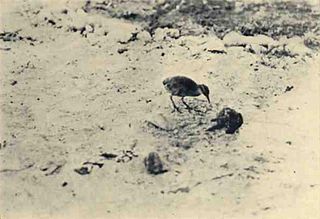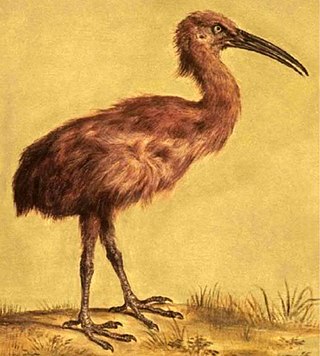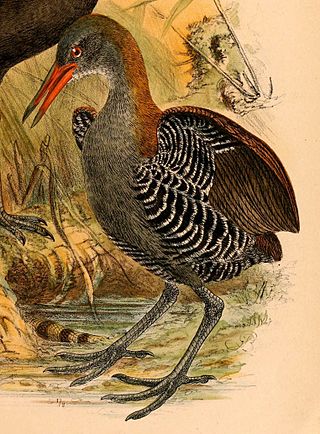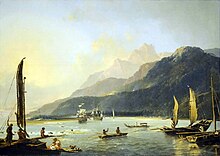
Rails are a large, cosmopolitan family of small- to medium-sized terrestrial and/or semi-amphibious birds. The family exhibits considerable diversity in its forms, and includes such ubiquitous species as the crakes, coots, and gallinule; other rail species are extremely rare or endangered. Many are associated with wetland habitats, some being semi-aquatic like waterfowl, but many more are wading birds or shorebirds. The ideal rail habitats are marsh areas, including rice paddies, and flooded fields or open forest. They are especially fond of dense vegetation for nesting. The rail family is found in every terrestrial habitat with the exception of dry desert, polar or freezing regions, and alpine areas. Members of Rallidae occur on every continent except Antarctica. Numerous unique island species are known.

The Inaccessible Island rail is a small bird of the rail family, Rallidae. Endemic to Inaccessible Island in the Tristan Archipelago in the isolated south Atlantic, it is the smallest extant flightless bird in the world. The species was described by physician Percy Lowe in 1923 but had first come to the attention of scientists 50 years earlier. The Inaccessible Island rail's affinities and origin were a long-standing mystery; in 2018 its closest relative was identified as the South American dot-winged crake, and it was proposed that both species should be nested within the genus Laterallus.
The Calayan rail is a flightless bird of the rail, moorhen, and coot family (Rallidae) that inhabits Calayan Island in the Philippines. It is the only member of the genus Aptenorallus. Though well known to natives of the island as the "piding", it was first observed by ornithologist Carmela Española in May 2004 and the discovery was officially announced on August 16, 2004. The formal description as a species new to science appeared in the journal Forktail.

Flightless birds are birds that, through evolution, lost the ability to fly. There are over 60 extant species, including the well-known ratites and penguins. The smallest flightless bird is the Inaccessible Island rail. The largest flightless bird, which is also the largest living bird in general, is the ostrich.

The Lord Howe woodhen also known as the Lord Howe Island woodhen or Lord Howe (Island) rail, is a flightless bird of the rail family, (Rallidae). It is endemic to Lord Howe Island off the Australian coast. It is currently classified as endangered by the IUCN.

The extinct Wake Island rail was a flightless rail and the only native land bird on the Pacific atoll of Wake. It was found on the islands of Wake and Wilkes, but not on Peale, which is separated from the others by a channel of about 100 meters. It was hunted to extinction during World War II.

The Rodrigues rail, also known as Leguat's gelinote or Leguat's rail, is an extinct species of the rail family that was endemic to the Mascarene island of Rodrigues. The bird was first documented from life by two accounts from 1691–93 and 1725–26. Subfossil remains were later discovered and correlated with the old accounts in 1874, and the species was named E. leguati in Leguat's honour. It is generally kept in its own genus, Erythromachus, but has sometimes been assigned to the genus Aphanapteryx along with its close relative the red rail of Mauritius; their relationship with other rails is unclear.

The red rail is an extinct species of rail that was endemic to the Mascarene island of Mauritius, east of Madagascar in the Indian Ocean. It had a close relative on Rodrigues island, the likewise extinct Rodrigues rail, with which it is sometimes considered congeneric, but their relationship with other rails is unclear. Rails often evolve flightlessness when adapting to isolated islands, free of mammalian predators, and that was also the case for this species. The red rail was a little larger than a chicken and had reddish, hairlike plumage, with dark legs and a long, curved beak. The wings were small, and its legs were slender for a bird of its size. It was similar to the Rodrigues rail, but was larger, and had proportionally shorter wings. It has been compared to a kiwi or a limpkin in appearance and behaviour.

Gallirallus is a genus of rails that live in the Australasian-Pacific region. The genus is characterised by an ability to colonise relatively small and isolated islands and thereafter to evolve flightless forms, many of which became extinct following Polynesian settlement.

The buff-banded rail is a distinctively coloured, highly dispersive, medium-sized rail of the rail family, Rallidae. This species comprises several subspecies found throughout much of Australasia and the south-west Pacific region, including the Philippines, New Guinea, Australia, New Zealand, and numerous smaller islands, covering a range of latitudes from the tropics to the Subantarctic.

Porzana is a genus of birds in the crake and rail family, Rallidae. Its scientific name is derived from Venetian terms for small rails. The spotted crake is the type species.

The invisible rail, Wallace's rail, or drummer rail is a large flightless rail that is endemic to the island of Halmahera in Northern Maluku, Indonesia, where it inhabits impenetrable sago swamps adjacent to forests. Its plumage is predominantly dark slate-grey, and the bare skin around its eyes, the long, thick bill, and the legs are all bright red. Its call is a low drumming sound which is accompanied by wing-beating. The difficulty of seeing this shy bird in its dense habitat means that information on its behaviour is limited.

The snoring rail, also known as the Celebes rail or Platen's rail, is a large flightless rail and the only member of the genus Aramidopsis. The species is endemic to Indonesia, and it is found exclusively in dense vegetation in wet areas of Sulawesi and nearby Buton. The rail has grey underparts, a white chin, brown wings and a rufous patch on the hind-neck. The sexes are similar, but the female has a brighter neck patch and a differently coloured bill and iris. The typical call is the snoring: ee-orrrr sound that gives the bird its English name.

Laterallus is a genus of birds in the rail family Rallidae. These small, relatively short-billed terrestrial rails are found among dense vegetation near water in the Neotropics, although a single species, the black rail, also occurs in the United States.

Dieffenbach's rail, known in the Moriori language as meriki or mehoriki, is an extinct flightless species of bird from the family Rallidae. It was endemic to the Chatham Islands.

The Okinawa rail is a species of bird in the rail family, Rallidae. It is endemic to Okinawa Island in Japan where it is known as the Yanbaru kuina. Its existence was only confirmed in 1978 and it was formally described in 1981 although unidentified rails had been recorded on the island since at least 1973 and local stories of a bird known as the agachi kumira may refer to this species.

The spotless crake is a species of bird in the rail family, Rallidae. It is widely distributed species occurring from the Philippines, New Guinea and Australia, across the southern Pacific Ocean to the Marquesas Islands and south to New Zealand.
The Macquarie rail, also known as the Macquarie Island rail, is an extinct subspecies of the buff-banded rail endemic to Macquarie Island, a subantarctic island that is part of the state of Tasmania, Australia. The holotype is in the collection of the Museum of New Zealand Te Papa Tongarewa.





















